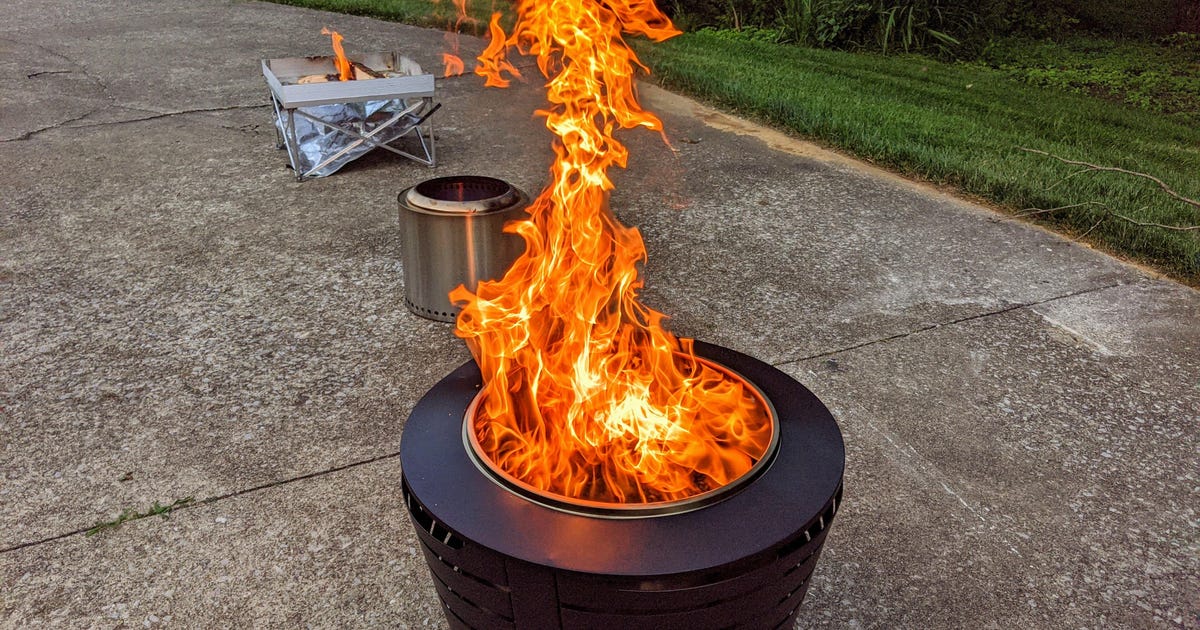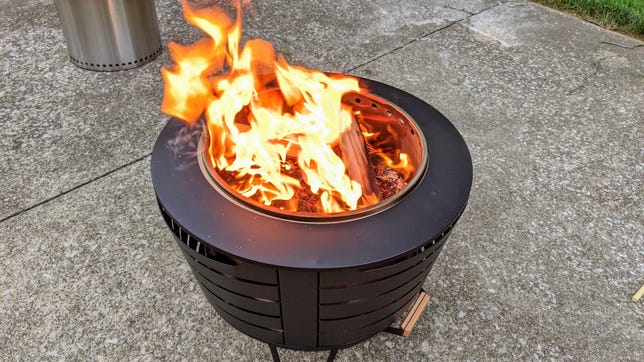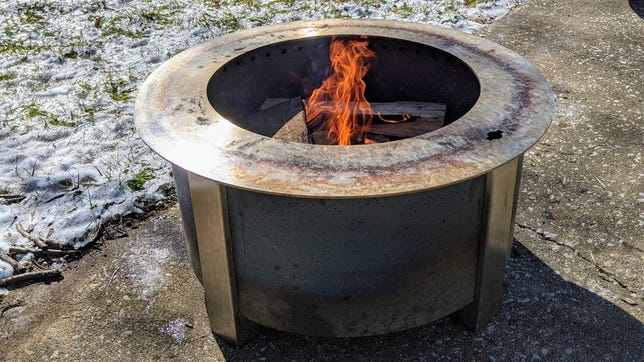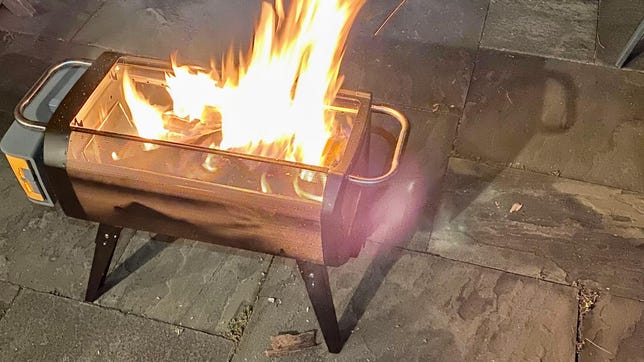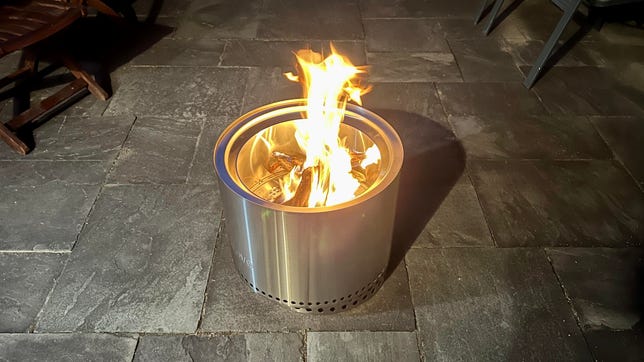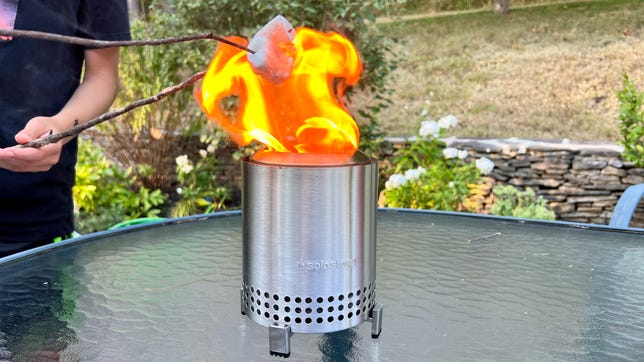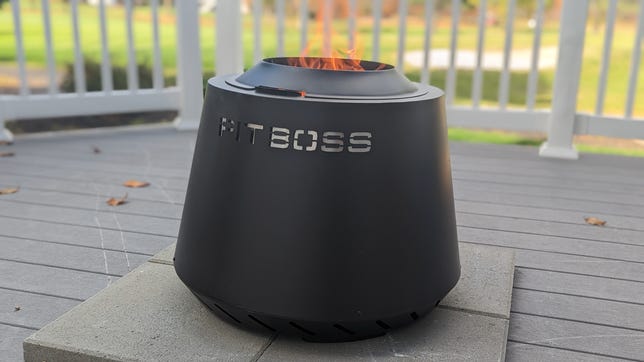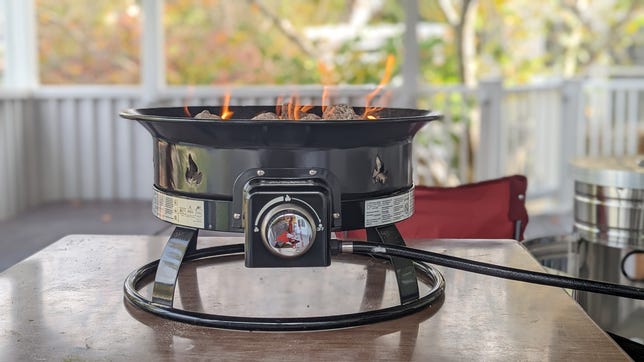In this article
As we wage deeper and deeper into winter, a fire pit becomes more and more appealing. It’s beautiful outside this time of the year, but it’s also very cold, which is why getting in close around a fire is so satisfying. Having a good fire pit in your outdoor space means you can sit around the warm glow with friends and family and roast marshmallows and hotdogs while looking at the night sky. If it sounds romantic, that’s because it is.
If you’re shopping for your first fire pit or looking for a replacement for the one that’s spent a little too long in the sun and rain, our list includes a variety of styles and sizes, so you can find an ideal fit for your yard and can stay cozy across multiple seasons.
Transforming your yard or backyard patio for a fire pit doesn’t require a huge commitment, so don’t worry. Some of the best fire pits are portable, so you won’t need to create a permanent space in your yard. Major retailers such as Amazon, Home Depot and Lowe’s carry them, and you can also buy directly from fire pit manufacturers.
Fire pits, which are essentially outdoor fireplaces, differ widely in size, weight and price. You can find inexpensive $50 models and high-performance pits that’ll set you back hundreds of dollars. You can even spend $1,500 or more on a fancy propane fire pit. Lots of them also come with extras like a cooking grate, so if you’re feeling extra outdoorsy, you can grab your cast-iron cookware and make your dinner over the embers in your backyard fire pit instead of in the kitchen.
Read more: 4 Reasons You Should Use a Cast-Iron Skillet
The models on this list are all from established outdoor brands, and they’re either bestsellers, highly ranked or worthy challengers for the best fire pit. We tested many backyard fire pits to determine their strengths and weaknesses, as well as the quality of the tools that come with them, whether that’s a cooking grate or just a fire poker. So, ready to gather round the bonfire? Let us help you choose the best wood fire pit for your backyard or patio. We’ll update this list of the best fire pit options periodically.
Best Fire Pits for 2022
Brian Bennett/CNET
Our favorite fire pit on this list is made by Tiki, a company that began with the familiar Tiki bamboo torch over 60 years ago. Now Tiki offers a fire pit that’s large, sturdy and attractive. Priced almost $300 more than its budget rivals, this pit has performance, ease of use and superior style that make it worth the investment.
The steel and stained-wood pit doesn’t just look good. The Tiki Brand Fire Pit has a clever airflow system that recycles hot smoke back into the fire chamber. During our testing, it was easy to ignite, firing up in about 5 minutes and fully burning in 15.
It also generated far less smoke than the other fire pits we tested, especially after its logs caught fully, usually at about the 15-minute mark. Only the Solo Stove Ranger burned wood with less smoke emission, its fuel burning fiercely in 5 minutes. The Tiki Fire Pit’s logs burned efficiently as well, lasting for hours.
Because of its large (16 inches in diameter) mouth, it’s easier to share the fire with multiple people. The Solo Stove Ranger is smaller, with a metal fire ring of 10 inches in diameter. Kids gathering around to roast s’mores need to be careful, though: All surfaces of the Tiki fire pit, including its metal lip, are scalding hot after the fire is lit. It also takes time to cool after the flames die down.
We do appreciate the Tiki Brand pit’s removable ash pan. It makes for easy cleanup. The pit puts out a generous amount of heat; while that’s perhaps not ideal for hot summer nights, it’s excellent when the temperature dips during the fall and winter. Finally, tipping the scales at 45 pounds, this fire pit is heavy. Think twice before you position it, and get help when you do.
Brian Bennett/CNET
To say the Breeo X Series 24 is built to take a beating is an understatement. Manufactured in Lancaster, Pennsylvania, the X Series is constructed from a mix of corten (weathering) steel and 304 stainless steel. As a result, the X Series doesn’t require a rain cover or weather shelter. In fact, after six months of exposure to the elements, the outer wall of the fire pit develops a natural patina that protects it from corrosion.
The X Series also has an advanced airflow system designed to facilitate secondary fuel burn, similar to the smokeless fire pits from Solo Stove. While not as easy to ignite as the Solo Stove pits, the X Series definitely stays lit once you get the fire going, and when it’s done properly, the process takes 5 minutes and only requires smaller logs and kindling at first. It puts out plenty of heat as it burns away at full temperature, but the pit’s secondary burn releases hardly any smoke.
Also nice to have is the X Series’ stainless-steel sear plate. It rings the fire pit’s outer edge and spans a diameter of 29.5 inches. The plate gets hot enough to cook burgers, chicken and other savory items, and you can also use it to heat pots, pans and skillets.
You have a couple of accessories to consider, too. Up first is Breeo’s SearPlate griddle cooking attachment, a $250 accessory that creates a convenient grilling surface. Breeo also sells a $130 stainless-steel lid for the X Series. It’s designed to shield the pit from excess moisture when not in use.
One last note: Be sure to think hard about where you want to deploy this pit. Weighing in at 78 pounds, the X Series 24 is 33 pounds heavier than the second heftiest pit in this group, the Tiki Fire Pit. I recommend asking a friend or two to help move it where it needs to go in your yard or patio.
David Carnoy/CNET
The FirePit Plus, made by Brooklyn-based BioLite, weighs under 20 pounds and is built for portability. Measuring 27 by 13 by 15.8 inches, it’s relatively long and narrow, making it really good for patio use. However, it holds a little more wood than you’d think, with room for up to four cordwood logs. You can either use it as a standard fire pit or as a backyard grill and it was upgraded in 2021 with an enamel coating for easier cleaning and a higher-capacity battery for its built-in fan. It can also work as a patio heater.
In fire pit mode, you lower the fuel rack to the bottom of the pit. To use it as a free-standing grill, so you can cook over hot wood coals or charcoal briquettes if you prefer, raise the rack to its highest position. BioLite offers a bundle with a grill grate that sits over everything. The grill lit up fast, in less than 5 minutes, and was fully burning in less than 10.
The FirePit Plus has a couple of signature features, one being patented airflow technology. A motorized fan powered by the flames’ heat output drives air to the fire box. You can also control it using an iOS or Android app on a phone using Bluetooth. A mesh body lets you see flames through the FirePit from any angle.
In the new version, battery life has improved by about 20%, with up to 30 hours at the low setting, 14 hours on medium and 7 hours on high. The airflow technology also helps create an almost smoke-free fire, making it suitable as a patio heater. The FirePit Plus’ legs fold up when you want to take the grill on the go, plus the pit comes with a handy rain cover. A removable ash tray makes cleaning up easy.
All in all, this is a compelling little fire pit for someone who doesn’t want (or can’t have) a permanent pit always eating up patio space.
David Carnoy/CNET
Solo Stove fire pits are among the best smokeless fire pits out there, and while they work great and their stainless steel construction gives them a sleek appearance, the original models had one flaw: They weren’t so easy to clean up. However, that changed with the arrival of the new Solo Stove 2.0 fire pits, which are available in the same three sizes — Ranger 2.0 (small), Bonfire 2.0 (medium) and Yukon 2.0 (large) — and have a removable ash pan, a feature missing from the 1.0 models.
We tested the midsize Bonfire 2.0 model, and it was a breeze to get fires started — the 2.0 fire pits have the same 360-degree Airflow Technology that allows for smokeless fire — and on the outside, the 2.0 fire pit looks the same as the 1.0 version. The difference is on the inside: once your fire has gone out and fully cooled down, you simply remove the screen over the pan, which collects the majority of the cinders, then remove the pan itself and dump the remaining ash (you no longer have to turn over the fire pit to remove the ash). A bit of the finer ash can end up at the bottom of the fire pit basin after you remove the pan but that’s easy to remove with a wet rag or paper towel. Solo Stove fire pits are efficient. They consistently consumed our test logs and produced a lot less smoke than other fire pits we’ve tested. As with other high-performance fire pits, kids (and adults) need to be careful around the Bonfire 2.0. In addition to the intense heat from the fire itself, the Bonfire’s steel surface heats to burning temperatures fast.
We previously tested Solo Stove’s larger Yukon fire pit (it’s currently on sale for $440) and it’s also great but a little hard to move around on your patio or in your yard since the 2.0 version weighs 41.6 pounds (18.9 kg) compared to 23.3 pounds (10.6 kg) for the Bonfire 2.0. A variety of accessories are available for all of Solo Stove’s Fire Pit 2.0 models including its new Stand 2.0 and a rain cover. A carrying sack is included with all models.
David Carnoy/CNET
Solo Stove, which makes some of the best smokeless fire pits, released its second-generation Ranger 2.0 (small), Bonfire 2.0 (medium) and Yukon 2.0 (large) fire pits in August of 2022. Now it’s gone extra small for its new Mesa fire pit.
As its name implies, the Mesa is designed to sit on a tabletop and is small enough to slip into a backpack for mobility. Naturally, you could also set it on the ground, but when you put it on a table, it’s at a good height for comfortably roasting marshmallows. It has the same 360-degree Signature Airflow system as Solo Stove’s larger fire pits and is the spiritual successor to the Solo Stove Lite, a mini camp stove (whether we’ll see some camping accessories for the Mesa is unclear at this point). It’s an excellent mini fire pit.
James Bricknell / CNET
Using a pellet fire pit instead of wood is a different experience. The smell can be different, especially if you throw in some pellets designed for smoking meats, and the fire feels more intense. The Pit Boss pellet fire pit kept me warm even from 6 feet away on a brisk November morning and the pellets lasted a good long while before they needed a refill.
Like a lot of modern fire pits the Pit Boss uses a design to catch the smoke and recirculate it so you mainly get fire rather than smoke. Lighting it was easy, though pellet pits can take an external accelerant to get going. I used a small spray of barbecue lighter fluid on mine and it worked perfectly. It does release more smoke as you start it, but that goes away as the fire heats up.
It also comes with a quality-feeling cover to keep the rain off, and a removable ashtray to make dumping out the pellet ash pain-free. Pellets burn more evenly than wood chunks so the ash never has unburned lumps. I think I like pellet pits more than wood now, and the Pit Boss has helped me in that decision.
You’re receiving price alerts for Pit Boss Pellet Fire Pit
James Bricknell / CNET
While most of our selections are wood-burning fire pits, there is something to be said for propane choices. This 19-inch fire pit from Outdoor Living fits neatly on a table or the ground and is perfect for people who already use propane for their grills or patio heaters.
The Firebowl has a nice long hose to keep your gas tank away from the open flame, so it is safe to use. It gives off a significant amount of heat; because it is gas, heat can be adjusted as needed. A fire pit that can start the evening on a low setting for the ambiance and finish it with a roaring fire to keep the chill away is a luxury that wood burners don’t offer.
The Firebowl also comes with lava rocks, perfect for creating the illusion of a bonfire, as they add carbon to the flame, making it yellow instead of blue. They also help keep the heat going, even if you turn the gas off to conserve it. One big advantage of a gas fire pit is instant heat. There’s no waiting for the fire to get going; it’s just the heat you want when you want it.
Other top fire pits
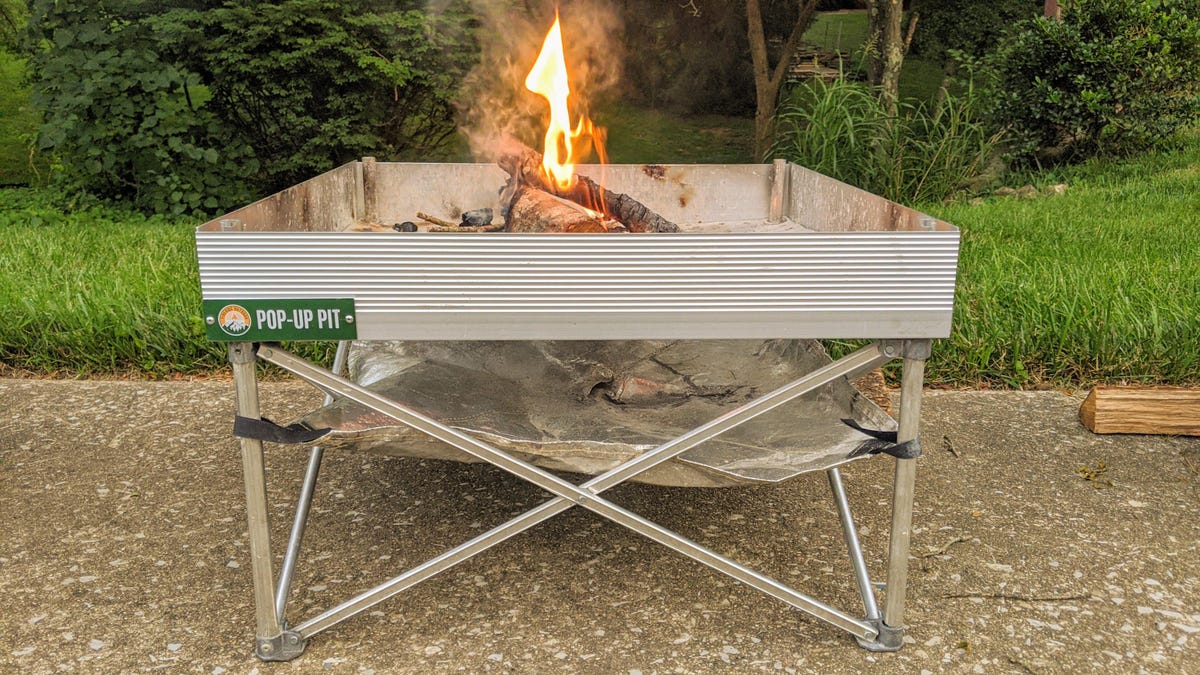
The Pop-Up Fire Pit is very portable but makes a lot of smoke.
A metal “pop-up” fire pit table outside with a small flame burning.
Pop-Up Fire Pit: The most portable fire pit idea in this roundup is the Pop-Up Pit. Its collapsible design lets you assemble it and break it down quickly. It also uses a heat shield so it won’t scorch the ground below. The pit offers a large (2-foot-square) burning surface for your fire, too. Since its frame is constructed from stainless steel, the Pop-Up Pit is rust-resistant. However, because the pit is so large and has low walls, it creates a lot of smoke.
Brian Bennett/CNET
Solo Stove Ranger: Squat, cylindrical, compact and made from stainless steel, the Solo Stove Ranger appears simple at first glance. Tucked away inside this pit, though, is the same sophisticated airflow system that its larger sibling, the Solo Stove Yukon, has. The system is designed to enable fire in the pit to burn hotter and consume more of its wood fuel.
We can confirm that the Ranger delivers on these promises. It starts fast, with its logs aflame in just 5 minutes, and it burns for hours. The fires we started in the Ranger also burned with incredible ferocity. The flames inside the pit focused into an impressive rolling vortex. Despite the conflagration, the Ranger emitted very little smoke.
The Ranger does have a few drawbacks. Its compact size means it can’t accept standard 15-inch firewood logs. It’s also not the best for large groups or families. More than two people roasting marshmallows at once quickly becomes a crowd.

The Kingso 22-inch fire pit is small and has poor airflow.
Brian Bennett/CNET
Kingso Outdoor Fire Pit (22-inch): Though it’s a bestseller on Amazon, we don’t recommend purchasing the Kingso Outdoor Fire Pit. Its small size (22 inches in diameter) feels cramped. And since airflow throughout the small fire pit unit is poor, we consistently had difficulty both starting fires and keeping them lit inside this pit. It doesn’t come with a protective cover, either.
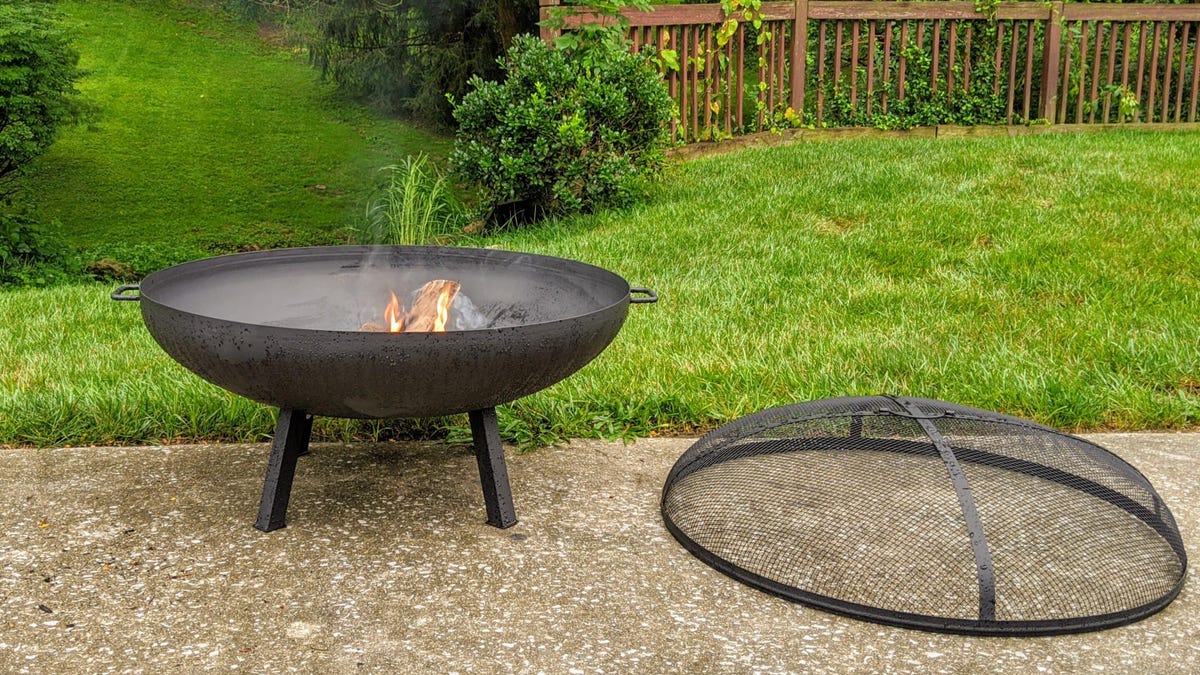
The Hampton Bay Windgate 40-inch Dia Fire Pit is massive and built from heavy steel. Unfortunately, it suffers from poor airflow so its flames often die out.
Brian Bennett/CNET
Hampton Bay Windgate 40-inch diameter round steel wood-burning fire pit: The Hampton Bay Windgate is by far the largest fire pit in this group. It has a massive 40-inch-diameter fire bowl, roomy enough for big groups to gather around. As the pit weighs in at a substantial 60 pounds and is constructed from heavy-duty steel, it takes a lot of effort to set up the pit where you want it. Unfortunately, the Windgate steel fire pit suffers from poor ventilation. As a result, fires we started in the pit consistently died out in 15 to 20 minutes. That makes it difficult to recommend this wood-burning pit model.
A good fire pit will ignite in minutes and stay lit for hours.
Brian Bennett/CNET
Factors to Consider
-
Ease of ignition
Check how the fire pit ignites, and if it requires wood, or if it has smart features like igniting via an app.
-
Ease of cleaning
Consider how easy the fire pit is to clean, including if it has a removable ash pan.
-
Portability
Consider if you plan to move the fire pit around your yard, or if you want it stationed in one place.
-
Cooking accessories
Decide if you want to use your fire pit for cooking, and which models include cooking tools.
How we tested fire pits
Wood-burning fire pits
To test each fire pit, we used the same fuel, Simple Simon Premium Hardwood sourced from a local Lowe’s. For a consistent amount, we selected three split log lengths roughly 15 inches long. We then stacked the logs together so at least some portion of each was touching the others.
To ignite each pit, we used Diamond Strike-a-Fire fire starters that were available at our neighborhood Kroger supermarket. One of these starter matches should be all that’s required to get a fire pit’s fire burning. We then logged how long it took to establish a fully sustained fire.
A good fire pit will fully ignite in five to 10 minutes. A pit with poor airflow and design will take a lot longer, or even flame out after 15 minutes no matter how well you’ve stacked your wood. Additionally, we made note of how much smoke escaped each pit. Ideally, a fire pit will generate a lot of flame and little smoke. A quality fire pit will also burn fuel efficiently, leaving little solid material remaining once its fire burns out naturally.
Gas fire pits
Gas fire pits are easier to test as they don’t require any lighting time. The first checks we do involve safety: Are all of the gas fittings secure and in good working order? Is the hose the recommended length to ensure the propane tank doesn’t get hot? These checks are the most important to keep everyone safe.
Next, we marked lines at 2-, 4-, 5-, 6-, and 7 feet. We then sat three people around the firepit at those distances to gauge how comfortable the heat was from the firepit. BTU is the standard unit of measure for heat, but knowing that doesn’t tell you how warm it makes you while you’re sitting at it.
Pellet fire pits
Like the wood-burning fire pit, we used the same fuel for each of the pits we tested. I used a two-gallon bucket filled with Traeger signature blend wood pellets as the fuel and two shot glasses of Kingsford lighter fluid as the accelerant. We then timed how long the fire took to reach full flame and how long it took from ignition to the flame going out.
Pellet fire pits will ignite much quicker than a standard log flame and will continue to burn evenly until they go out. Neither pellet nor wood was more expensive to test as the wood burns longer, but the pellet is cheaper to buy in bulk.
Fire pit FAQs
What is the best type of fire pit to buy?
The type of fire pit you should purchase depends on two main considerations. First is how much money you plan to spend. For instance, inexpensive pits are almost always basic cast-iron models that lack fancy smokeless airflow systems. The second factor to think about is how you’d like to use your pit. Simple pits provide the heat, sights and sounds of a crackling fire. They’re also fine for making s’mores and the odd hot dog. For more advanced cooking capabilities you’ll have to spend more for a pit also designed to operate as a true outdoor grill.
Which fire pits give off the most heat?
While all fire pits generate heat, some tend to create more than others. Ordinary pits, which are also the cheapest, can put out a good amount of heat. Unfortunately they typically create a lot of smoke as well. Smokeless fire pits do reach higher temperatures since they’re designed to foster a high degree of airflow as they burn. However, in my experience, Solo Stove fire pits channel much of their heat upward. Breeo pits, on the other hand, tend to push more heat outward so you often feel their warmth more.
Which smokeless fire pit is the best?
From a pure smokeless performance standpoint, Solo Stove fire pits are the best. They’re the easiest to start and keep lit. They also produce the least amount of smoke and generate the most intense, eye-catching flames. That said, since Solo Stove pits push much of their heat upward, they’re not ideal for keeping seated groups comfortable on cold winter nights. And they’re not designed for cooking elaborate outdoor meals either.
Can you put a fire pit on grass?
Yes, you can put a fire pit on grass — but you need to take a few precautions. For one, you’ll want to make sure the grassy area you choose is level, so the pit doesn’t tip over. You’ll also want to avoid damaging your grass: The high temperatures coming from a fire pit cause heat stress to your grass, which can discolor or kill it. The best way to protect your grass from damage is to put a barrier between the fire pit and the grass. You can simply put some patio slabs underneath the fire pit, or buy a heat shield or a fire-resistant mat. Whatever solution you go with, you should make sure to move the fire pit around frequently, so as not to damage grass in one location.
What types of ignitions are there for fire pits?
Fire pit ignition systems range from simple ones using a match to complex ones using electronics and an app. At one end of the spectrum are match-lit fire pits, with which you start the gas and light a match to get it started, and that’s it. The next step up is a spark ignition system, which features a battery-operated sparker, so you just push a button to get the flame going. Moving up another notch is a flame-sensing fire pit, which has a spark ignition but also a flame sensor that can stop gas flow once flames die down for extra safety. At the far end of the spectrum are electronic ignition kits, which also are flame-sensing, and have an automated ignition process that can be controlled with a timer, a switch, a remote, or a phone app. These are the most expensive, and often require you to have electricity at your fire pit.
Can I cook on my gas fire pit?
Cooking on a gas fire pit that isn’t specifically built for cooking is not recommended, the only exception being toasting marshmallows, since they only touch the flame and not the pit itself. However, some fire pits do sell accessories that you can add for safe cooking, and others are designed with cooking in mind.

